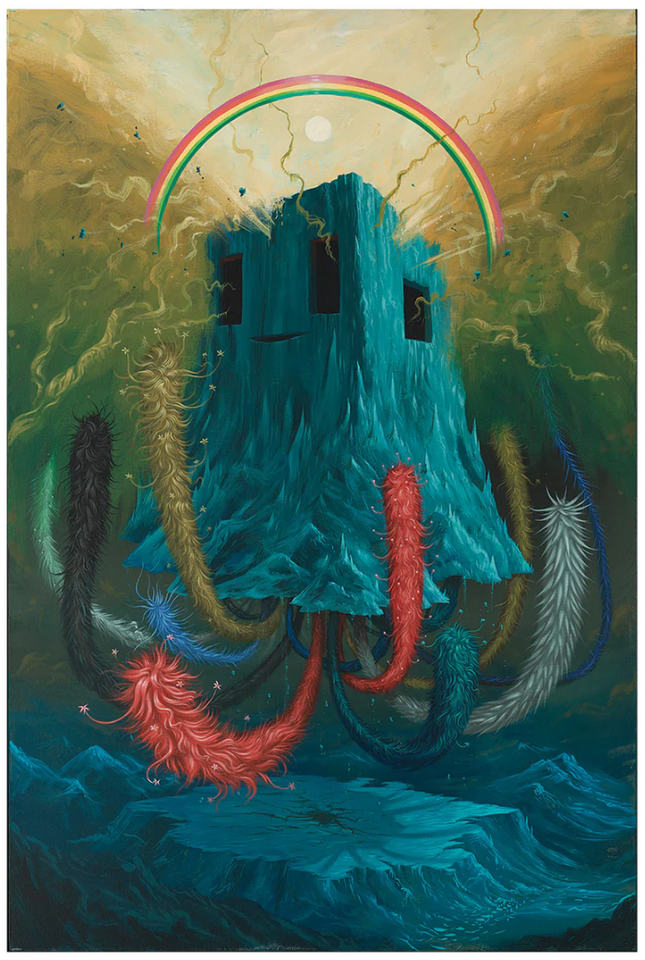
Rainbow

Jeff Soto Rising Offset Lithograph Print by Jeff Soto
Rising Offset Lithograph Print by Jeff Soto Print on 80# Patina Matte Fine Art Paper Limited Edition Hand-Pulled Street Pop Artwork Graffiti. 2010 Signed & Numbered Limited Edition of 450 Offset Lithograph Artwork Print Size 21.88x30 Jeff Soto's "Rising": A Testament to the Evolution of Street Pop Art Jeff Soto's "Rising" is a compelling piece demonstrating the fluid boundaries and the continuous evolution of Street Pop Art and Graffiti Artwork. As an offset lithograph print, "Rising" brings the tactile sensation of street textures to a refined art paper, bridging the ruggedness of outdoor walls and the delicacy of indoor galleries. Released in 2010, this print is part of a limited edition series, with each of the 450 pieces signed and numbered, underscoring the work's exclusivity and collectability. Measuring 21.88x30 inches, the artwork commands attention with its large format, allowing viewers to immerse themselves in Soto's distinctive vision. Printed on 80# Patina Matte Fine Art Paper, "Rising" showcases Soto's artistic expertise and his commitment to quality and durability, ensuring that the vivid colors and intricate details are preserved. The striking imagery of "Rising" encapsulates Soto's graffiti roots while pushing into fantasy and surrealism. His work is characterized by an organic blend of mechanical elements and natural forms, creating a post-apocalyptic yet whimsical world that has become his signature style. The hand-pulled quality of the lithograph adds a personal touch akin to the unique flair of hand-made graffiti, making each print a singular piece despite being part of a more extensive series. Exploring the Depth of "Rising" by Jeff Soto In "Rising," Soto explores growth, decay, and rebirth themes—concepts often associated with graffiti's transient nature and the ever-changing urban environment. The print depicts a fantastical landscape where organic and robotic elements intertwine under a celestial arch, suggesting a narrative of interconnectedness and coexistence. This piece emulates how Street Pop Art often delves into social commentary, using visual metaphors to reflect on the relationship between humanity and nature, technology, and tradition. Soto's choice of colors, from the earthy tones of the background to the vibrant hues of the creature-like forms, creates a visual symphony that draws the eye and provokes thought. The meticulous detail and layering techniques utilized in "Rising" are reminiscent of the intricate stencils and stickers of street art, where each layer contributes to the overall impact of the image. Jeff Soto's Legacy in the Intersection of Art Worlds The impact of "Rising" extends beyond its visual appeal, contributing to the discourse on the intersection of street art with traditional acceptable art practices. As an artist, Jeff Soto represents a generation that has grown from the raw energy of the streets to establish a presence in the fine art world without losing the essence of their origins. "Rising" is a testament to this journey, embodying the spirit of graffiti in a form that resonates within the white-walled galleries of the art establishment. The print's limited edition status adds a layer of significance, paralleling the unique, one-off nature of street art pieces that may only exist for a moment before being altered or erased. Collectors of Soto's work are often attracted to the dual nature of his art—both ephemeral in concept and permanent in execution, a duality at the heart of much of Street Pop Art. Jeff Soto's "Rising" is a vibrant homage to the transformative power of art, blurring the lines between street and gallery, temporary and lasting, real and imagined. As a piece of Street Pop Art, it captures the essence of graffiti's impact on contemporary art, offering a window into the rich, complex narratives that street artists weave through their work. Each print from the limited edition series stands as a fragment of a larger story, a snapshot of the evolving dialogue between the artist, the viewer, and the spaces they share.
$190.00


